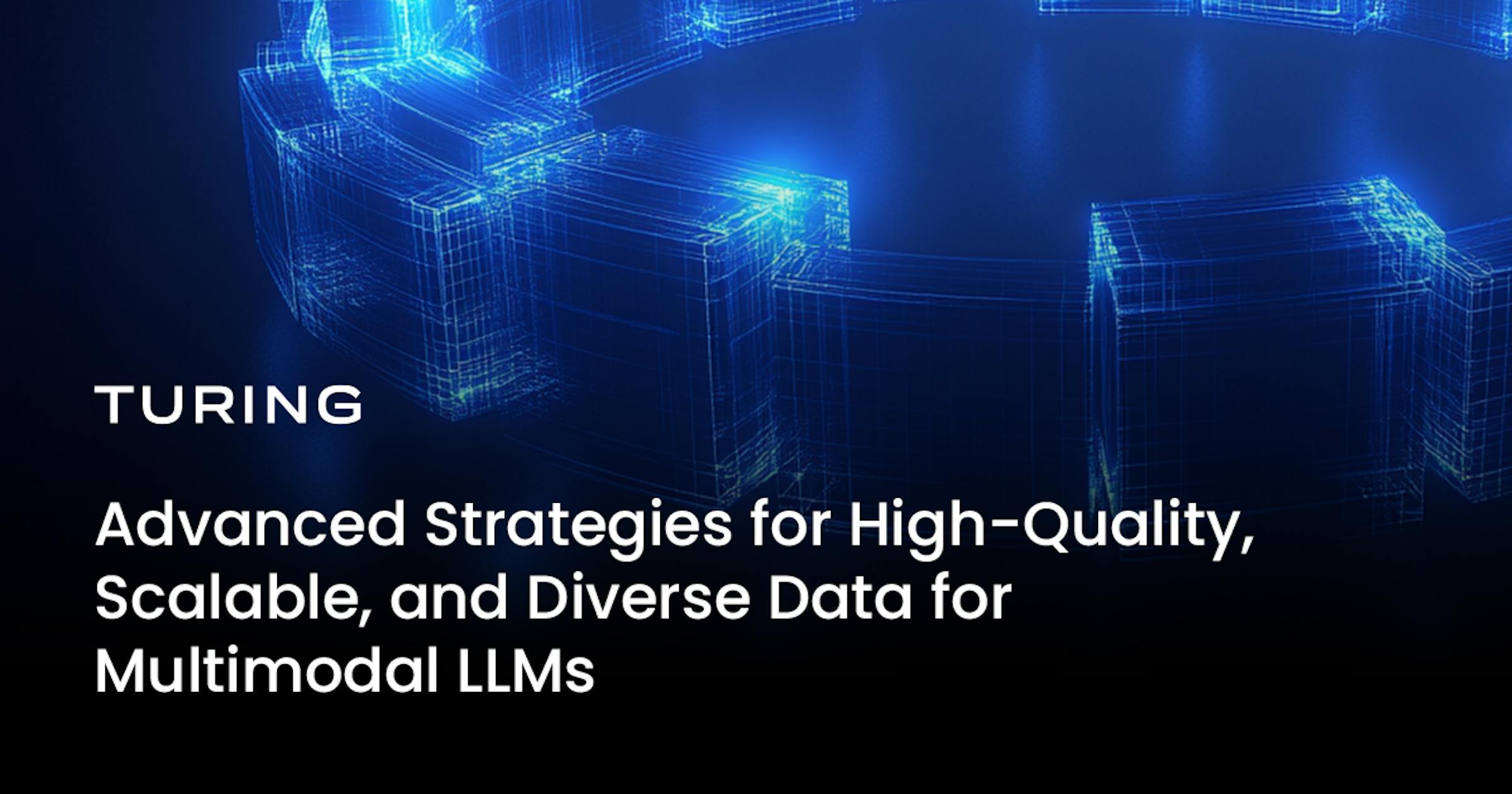Advanced Strategies for High-Quality, Scalable, and Diverse Data for Multimodal LLMs

Turing Research Council
•7 min read
- LLM training and enhancement

This brief shares practical insights from Turing AGI Advancement’s recent collaboration with a leading AI lab to build large-scale multimodal datasets, spanning vision, language, and audio, for instruction tuning, alignment, and evaluation. The work involved scaling human-in-the-loop (HITL) systems, evolving taxonomies, and navigating ethical and operational complexities in multimodal data generation.
The multimodal data challenge: Getting beyond volume
As organizations push toward more capable and generalizable multimodal LLMs, data becomes a major bottleneck, not just in terms of quantity, but in strategic composition and delivery. Three interlinked challenges consistently emerge:
- Quality: Multimodal data often suffers from weak alignment, poor annotation consistency, or low contextual relevance, especially when scaling across languages, formats, or domains. Without clear calibration, even sophisticated prompts can generate noisy or misaligned outputs. Projects that lack robust quality-control pipelines frequently encounter slow feedback loops, annotation drift, and uneven performance across modalities.
In a high-volume vision understanding project, our teams had to adapt to evolving taxonomies midstream, quickly recalibrating on new categories without compromising annotation quality. - Diversity: It’s not enough to gather a large dataset; the data needs to reflect a diverse set of capabilities, users, and real-world contexts. Rigid or outdated taxonomies often prevent full-spectrum coverage. Diversity needs to be actively designed: across demographics, domains, modalities, and intent types.
Recently, a medical and safety-critical project required sourcing varied data like imaging modalities, accents, or multilingual prompts, sometimes requiring new sourcing strategies to cover underrepresented cases. - Efficiency: Manual processes quickly become a bottleneck. Without intelligent tooling and structured agentic flows, annotation becomes slow and inconsistent, especially when working across vision, audio, and text.
Our Pod-based HITL teams with embedded reviewers and automated support systems enabled fast adaptation to delivery goals, even as category definitions changed midstream.
Strategic tradeoffs in multimodal data development
Building high-quality multimodal datasets isn’t just about applying best practices; it’s about navigating tensions between quality, diversity, and efficiency. Teams frequently encounter tradeoffs such as:
- Speed vs. quality: Automation can accelerate throughput but may increase label noise if not paired with rigorous validation.
- Diversity vs. efficiency: Expanding taxonomy coverage or sourcing rare data types slows delivery unless supported by adaptable workflows.
- Consistency vs. flexibility: Midstream updates to category definitions or prompt formats can improve coverage but require recalibration and retraining.
When a vision RLHF project introduced new label categories mid-delivery, our team avoided disruption by using calibration gold sets and a pod-based knowledge transfer model.
At Turing, we work closely with clients to strike the right balance for their model goals, customizing solutions based on the tradeoffs that matter most for their use case.
The real-world playbook for building better multimodal datasets
Solving for scale, quality, and diversity in multimodal datasets requires flexible frameworks, evolving taxonomies, and agentic HITL systems that adapt to the pace of model development. Below is a breakdown of how each core challenge can be tackled, with lessons drawn from real-world deployments.
1. Improving quality with AI-driven calibration and QA systems
Ensuring consistent, high-quality data across modalities means actively aligning annotators, prompts, models, and review mechanisms.
Key practices:
- Gold sets for calibration
Standardized datasets help benchmark annotator accuracy and consistency. These are essential for onboarding, drift detection, and grounding feedback discussions.
Our projects with early-stage gold batches established strong baselines that helped us maintain quality even when category definitions shifted. - Iterative refinement loops
Structured retrospectives across training cycles uncover prompt failure patterns or annotation mismatches. Teams revise annotation guidelines and evolve processes continuously, avoiding the “set and forget” trap.
Instruction tuning workflows helped us regularly refine prompt formats after observing reward model confusion, limiting misalignment downstream. - AI-driven calibration techniques
Models can help calibrate themselves. Methods like uncertainty quantification and expected calibration error (ECE) reduction serve as proxies for annotation quality, especially when paired with real-time dashboards that track drift and gaps. “Garbage in, garbage out” becomes real when misaligned annotations ripple into RLHF confusion or degraded eval performance. - QA pipelines as continuous systems
Quality assurance is layered and modality-specific. Tiered QA, including golden comparisons, consensus checks, and post-model evaluation, keeps the loop active and actionable.
We created vision datasets that passed through a two-stage QA process combining Gemini-based LLM screening with final human review. - Knowledge transfer through pod-based structures
To ensure annotation consistency at scale, teams often use pod-based systems, where experienced leads guide sub-groups, reinforce standards, and resolve edge cases. This structure supports fast onboarding and helps maintain quality under shifting conditions.
When working with large, distributed teams, this structure ensured that domain knowledge and updated calibration rules were quickly propagated without introducing drift.
2. Designing for diversity with flexible, evolving taxonomies
Multimodal model robustness depends on exposure to diverse tasks, formats, and viewpoints, but that only happens when taxonomies are built to evolve and capture complexity.
Key practices:
- Clear taxonomy definitions and evolution plans
Categories must come with detailed definitions, edge cases, and intended use documentation. As projects grow, taxonomies often expand or shift, and systems need to absorb those changes without breaking.
When new categories were introduced midstream in a vision RL project, strong calibration protocols allowed the change to propagate in hours, not days. - Embedding diversity in the design layer
Structured prompt templates, like Anthropic’s “helpful, honest, harmless” criteria, help steer data collection toward broader representations and reduce demographic blind spots.
Another example is Hugging Face Dataset Cards that have become a common tool to explicitly state labeling rationales, ethical considerations, and representational gaps. - Coverage-aware monitoring
Real-time dashboards that track label distribution help avoid imbalance. If a taxonomy includes 20 categories but 80% of the data falls into 3, the model’s ability to generalize suffers.
Trade-off:Coverage versus efficiency often emerges and teams must decide when to slow down to intentionally rebalance data flows.
3. Driving efficiency with agentic HITL workflows
Manual annotation at scale is resource-intensive and slow. Teams are increasingly adopting agentic workflows, where AI systems augment or automate parts of the workflow while humans remain in control.
Key practices:
- HITL pods with embedded agents
Structured pods pair human annotators with AI agents that handle tasks like pre-labeling, ranking model responses, or routing ambiguous cases for human review.
These pods allowed rapid response when annotation criteria changed, without affecting delivery timelines. - Multi-LLM consensus frameworks
In many workflows, multiple LLMs provide candidate responses, which are then ranked or filtered using heuristic rules or crowd judgment. Disagreements trigger human review, improving both efficiency and reliability.
For example, DeepMind’s approach to building RLHF reward data used multi-turn ranking tasks that distilled label consensus through preference-based voting. - Synthetic-human blends for annotation
High-volume tasks increasingly rely on synthetic content, especially in long-tail or sensitive domains, but require human review to maintain trust and safety.
Operationally, these flows reduce annotation fatigue and increase consistency, while keeping a human-in-the-loop for final validation. - Real-time feedback infrastructure
Dashboards and coverage monitoring tools help teams detect drift, imbalances, or bottlenecks early, enabling faster iteration and resource shifts.
Ethical considerations: Safety, fairness, and consent
Multimodal systems raise complex ethical challenges: visual bias, speech biometrics, data provenance, and more. Embedding ethical frameworks into pipeline design is critical—not just as a compliance step, but as part of scalable data governance.
- Bias and fairness
Detecting and mitigating bias requires both technical tooling (e.g., WEAT, iEAT) and procedural methods (e.g., counterfactual augmentation, diverse reviewer pools, taxonomy balancing). Teams must define what “fair” means for a given use case and constantly monitor for drift.
In language safety tasks, our teams often experienced annotator fatigue due to adversarial or disturbing prompts, highlighting the need for mental wellness guidelines and task rotation. - Privacy and consent
Audio and image data introduce heightened sensitivity. Regulatory requirements differ by region, and what’s legal may not always align with ethical best practices. Data pipelines must integrate consent capture, differential privacy, and opt-out tooling from day one.
In voice capture projects, Turing teams designed collection flows that respected regional voice biometric laws, using synthetic noise overlays and in-field recordings for realism while protecting identity.
Looking ahead: Self-improving pipelines and dynamic standards
The future of multimodal data development isn’t just about getting bigger, it’s about getting smarter. Emerging approaches like self-improving pipelines, where model feedback dynamically guides data generation and selection, promise to close the loop between modeling and data ops.
Just as importantly, teams must co-create dynamic standards, for diversity, quality, and fairness, that evolve with the landscape and are built with the same agility as the models they support.
Turing AGI Advancement helps frontier teams turn messy data into scalable, human-aligned datasets that accelerate model readiness. From pod-based HITL systems to real-time QA and evolving taxonomies, we work side by side with you to build datasets that reflect your goals, without compromising speed, quality, or diversity.
Stuck with slow, inconsistent multimodal data pipelines?
Talk to a Multimodality Expert
Author
Turing Research Council
Share this post

